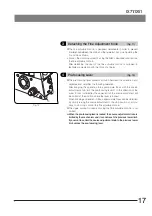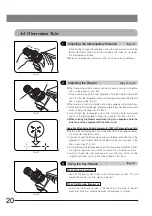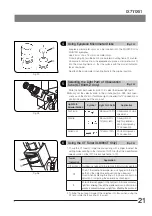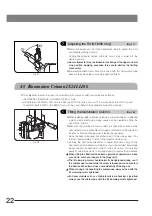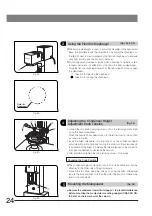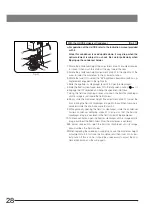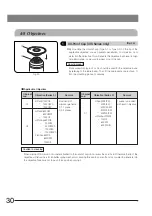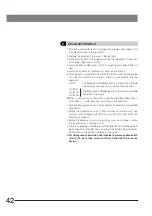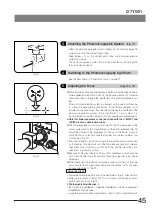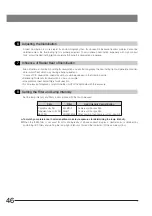
31
IX71/IX51
1. Correction is possible according to the vessel bottom thickness. (See
page 53,54 when the correction collar objective is used.)
When the thickness of the vessel bottom is known, match the scale
reading of the correction collar to the thickness of the vessel in use.
2. How to find the optimum position based on image resolution and contrast:
· If the thickness of the vessel bottom is unknown, the optimum position
for the correction collar can be obtained by judging the image resolution
and contrast. When a satisfactory image is not obtained after focusing,
rotate the correction collar to the left and right, refocus each time and
compare the images. Then rotate the collar in the direction yielding a
better image, and rotate the correction collar to the left and right, refocus
each time and compare the images. Repeat this cycle until the position
with the optimum image is found.
3
Using Immersion Objectives
(Fig. 45)
# Always use immersion oil supplied by Olympus.
}If the objective in use can accommodate the oil-proof cap, be sure to
mount the cap.
1. Using a low-power objective, bring the specimen into focus.
2. Rotate the revolving nosepiece to engage the oil immersion objective.
3. Remove the specimen and move the stage insert cut-out @ close to the
objective front lens. Apply a drop of the provided immersion oil to the
objective front lens. Place the specimen and rotate the fine adjustment
knob to bring the specimen into focus.
# Use as little oil as possible. Also remove the oil immediately after
use.
# If the oil contains air bubbles, the image will be degraded. Make
sure the oil is free of air bubbles.
a) To check for air bubbles, remove the eyepieces, completely open
the field iris diaphragm and aperture iris diaphragm, and look at the
objective exit pupil (looking like a bright circle) in the observation
tube. Any air bubbles can be seen in this way.
b) To remove air bubbles, slightly rock the revolving nosepiece manually to
engage and disengage the oil immersion objective once or twice.
4. After use, remove immersion oil from the objective front lens by wiping
with gauze slightly moistened with absolute alcohol.
}The same procedure is applicable when using a water-immersion
objective.
Caution on using the immersion oil:
If immersion oil comes into contact with your eye or skin, immediately
take the following action.
For eye: Rinse with clean water (for more than 15 minutes).
For skin: Wash with soap and water.
If the appearance of the eye or skin changes or pain continues, im-
mediately consult your doctor.
Fig. 45
@
2
Adjusting the Correction Collar

